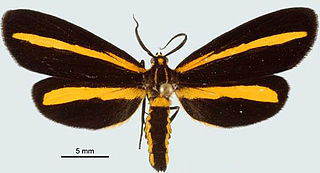Related Research Articles

Notodontidae is a family of moths with approximately 3,800 known species. The family was described by James Francis Stephens in 1829. Moths of this family are found in all parts of the world, but they are most concentrated in tropical areas, especially in the New World.

Plusiinae is a smallish subfamily of the moth family Noctuidae. As the Noctuidae appear to be a paraphyletic assemblage, the Plusiinae may eventually be raised to family status.

The gold spangle is a moth of the family Noctuidae. The species was first described by Michael Denis and Ignaz Schiffermüller in 1775. It is found in Europe, across western Siberia and the Altai Mountains, the northern Caucasus, northern Turkey and northern Iran.

Getta unicolor is a moth of the family Notodontidae. It is found in South America, including Peru, Ecuador, Colombia, Venezuela and Guyana.

Lyces annulata is a moth of the family Notodontidae. It is found from Venezuela to Peru along the eastern slopes of the Andes.
Erbessa citrina is a moth of the family Notodontidae first described by Herbert Druce in 1898. It is found in Peru, Venezuela, French Guiana and Brazil.
Erbessa euryzona is a moth of the family Notodontidae first described by Francis Walker in 1854. It is found in Brazil, Colombia, Venezuela, Ecuador and Peru.
Erbessa labana is a moth of the family Notodontidae first described by Herbert Druce in 1895. It is found in Venezuela, Ecuador, Peru and Brazil.
Phanoptis fatidica is a moth of the family Notodontidae. It is found from Venezuela west to Colombia, then south along the eastern slope of the Andes to central Peru.
Dioptis fatima is a moth of the family Notodontidae first described by Heinrich Benno Möschler in 1877. It is found in Brazil, Venezuela, Guyana, Suriname, French Guiana and Peru.
Dioptis trailii is a moth of the family Notodontidae first described by Arthur Gardiner Butler in 1877. It occurs at localities throughout the upper Amazon basin of Brazil and Peru, and is known from at least one locality in central Venezuela.
Azaxia luteilinea is a moth of the family Notodontidae first described by Herbert Druce in 1904. It is found in south-eastern Peru.
Disphragis anatole is a moth of the family Notodontidae. It is found in north-eastern Ecuador and possibly eastern Peru.

Disphragis notabilis is a moth of the family Notodontidae first described by William Schaus in 1906. It is found throughout the Amazon basin from western Venezuela east- and southward to at least Bolivia. The range includes French Guiana.
Malocampa bolivari is a moth of the family Notodontidae. It is found in Venezuela.
Meragisa dasra is a moth of the family Notodontidae. It is found in south-eastern Peru.
Meragisa nicolasi is a moth of the family Notodontidae. It is found in northern Peru.
Lepasta is a genus of moths of the family Notodontidae.
Lepasta majorina is a moth of the family Notodontidae. It is found in Colombia and Ecuador.
Nystaleinae is a subfamily of the moth family Notodontidae. The subfamily was described by William Trowbridge Merrifield Forbes in 1948.
References
- ↑ Miller, James S.; Thiaucourt, Paul (November 1, 2011). "Diversity of Prominent Moths (Lepidoptera: Noctuoidea: Notodontidae) in the Cloud Forests of Northeastern Ecuador, with Descriptions of 27 New Species". Annals of the Entomological Society of America. 104 (6): 1033–1077. doi:10.1603/AN10141.